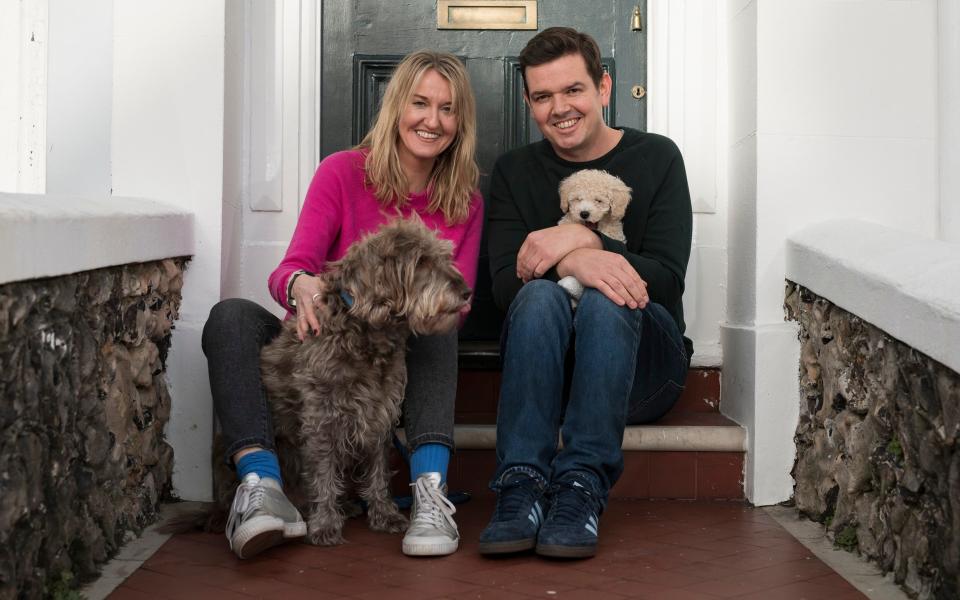What nobody tells you about living with a randy dog

You have to feel for Boris Johnson. The last thing any prime minister needs while trying to wrestle down a global pandemic is your randy pet dog rampaging around the workplace, imposing his “romantic urges” on anything that moves – or, for that matter, anything that doesn’t. “My dog is endless … on people’s legs,” the weary PM told officers at Surrey Police’s canine unit in Guildford, on Tuesday.
Humping, or mounting, is a common behavioural problem with dogs that many owners will be well aware of – as I’ve just discovered. Yes, we’re having a similar struggle with our own nine-month-old cavapoo, Wilbur, who, almost overnight, has gone from soft, cuddly and compliant to a rebel without a cause, regardless of the consequences. Just yesterday, he wandered into my son’s bedroom, stole his dental retainer from the bedside table and chewed it into an unrecognisable mess. That will cost £80 to replace.
But, like the Prime Minister’s Jack Russell-cross, Dilyn, it’s the humping that’s most concerning (and embarrassing). Yes, Wilbur is at an age where he’s suddenly succumbing to those urges that teenagers get. Until recently, he wasn’t a problem and his recall response was excellent. Now, though, whenever he sees another dog, even hundreds of yards away, there is nothing you can do or say to stop him from running over and introducing himself in an over-familiar way.
He doesn’t discriminate either: boys, girls, dogs, cats, soft toys, human legs – he’ll try his luck with anything. Friends of ours have Wilbur’s brother from the same litter, and whenever they see each other, he’ll try to hump him as well.
But it’s a habit that needs addressing, says Graeme Hall, a professional dog trainer best known for his work on the Channel 5 programme Dogs Behaving (Very) Badly. “If you’re not going to breed from him, consider neutering,” says the man dubbed “The Dogfather”. “If you leave it for too long, he might form a habit that’s still there even if you take away the root cause, so to speak.”
Who knows if, or when, Dilyn – now two – had the snip, but contrary to popular belief, humping isn’t just a behaviour unneutered male dogs engage in. Those that have been “done” can still do it and even females are known to try.

Not that it was ever like this with our other dog, Nell, a labradoodle. She’s nearly 10 now (mid-50s in human years) and has enjoyed a life of peace and tranquility, right up to the point where Wilbur came in like a wrecking ball. She just wants an easy life. Instead, she now lies in her bed, staring forlornly into the distance as this tiny curly demon thrusts away on her.
Kenny the cat is suffering too. From the moment Wilbur wakes up, he will follow Kenny around the house trying to either leap on his back and ride him, nibble his tail or, and there’s really no other way of saying this I’m afraid, lick his bottom.
It’s not the only disgusting behaviour in Wilbur’s repertoire. While he rarely does his business in the house anymore, he now has a habit of waiting for Nell to do hers, before eating it. It’s called “coprophagia”, apparently, it’s quite common and is something he will grow out of (we hope). The only positives about his putrid predilection is that a) it’s better for the environment than using bags, and b) it saves me from picking it up. It’s not so nice when, in a rare display of affection, he licks my face soon after.

Meanwhile, the humping just gets more regular and vigorous. But as Louise Glazebrook, dog behaviourist and trainer on the BBC2 series 12 Puppies and Us, explains, it is not always a sexualised behaviour. “I find it’s more about feeling overwhelmed, feeling insecure in certain situations and not knowing how to handle it,” she says. “Repetitive behaviours like humping can help a dog to channel the uncertain energy and it can provide a feeling of calmness eventually.”
Hall agrees. “Humping usually happens when dogs get excited in other ways, so keeping them calmer when meeting people and other dogs is the best approach,” he says. The best method of tackling it is to plan ahead and head off any possible encounters before it’s too late. Think treats and distractions and, says Glazebrook – and trying to understand why the behaviour is taking place in the first instance. “Owners should think about changing the situations their dog is being put in,” she adds. “Sometimes, it can just be too much for them.”
For more information visit @louise.glazebrook on Instagram or thedarlingdogcompany.co.uk
